When you want to take a photo in the water, not only simple camera which can take a photo but you also need their Equipment as well. Most of Underwater photographers have several basic options for equipment such as A compact digital point and shoot camera, a compact digital camera with full exposure controls, and an SLR.
photo: euphoria-magazine.com
Unlike earlier amphibious or waterproof camera such as the Nikonos, which is designed specifically for use underwater, these cameras now require a housing to keep them water proof. Nikon discontinued the Nikonos series in 2001 and it is a 35mm film system, so it is somewhat obsolete, but some photographers still choose this approach.
Sea and Sea continues to manufacture an amphibious range finder camera that utilizes 35mm film, the Motor Marine III. Housings are specific to the camera and are made of several things from inexpensive plastic to high-priced aluminum cases. Housings allow many options, since the user can choose a housing specific to their everyday "land" camera, as well as utilize any lens in their collection.
In practice, underwater photographers generally use either wide-angle lenses or macro lenses, both of which allow close focus, thereby eliminating the need to have excessive water between the camera and subject. Digital media can hold many more shots than standard photographic film. This is one of the primary advantages of using digital camera underwater, since it is impossible to change photographic film underwater.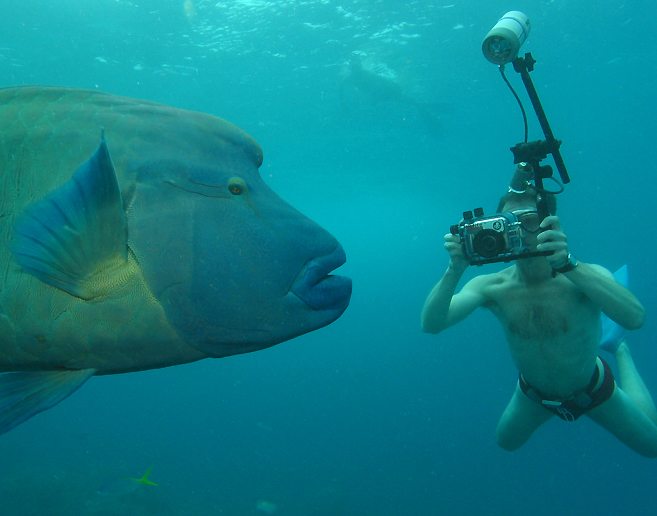
Photo: richard-seaman.com
The instant feedback provides faster learning and improved creativity, which is why virtually all underwater photographers now use digital cameras. All underwater housings are outfitted with controls knobs that access the camera inside, giving the photographer use of most of its normal functions. These housings may also have connectors to attach external flash units.
Some basic housings allow the use of the flash on the camera, but the on-board flash may not be sufficiently powerful and are improperly placed for underwater applications. More advanced housings either redirect the on-board strobe to fire a slave strobe via a fiber optic cable, or physically prevent the use of the on-board strobe.
Housings are made waterproof through a system of silicone o-rings at all the crucial joints. There are optical issues with using cameras inside a watertight housing. Because of refraction, the image coming through the glass port will be distorted, in particular when using wide-angle lenses. The solution is to use a dome-shaped or fish-eye port, which corrects this distortion. Most manufacturers make these dome ports for their housings, often designing them to be used with specific lenses to maximize their effectiveness.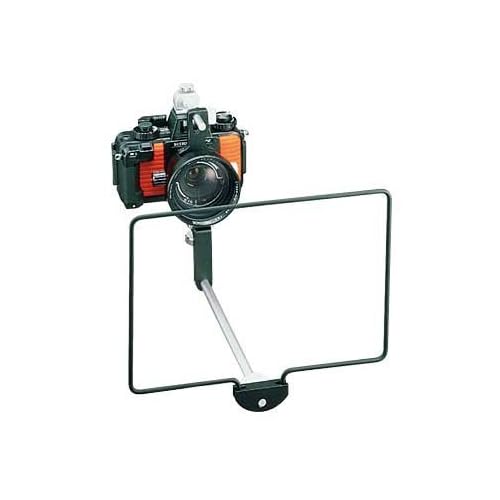
The Nikonos series allowed the use of water contact optics: ie, lenses designed to be used whilst submerged, without the ability to focus correctly when used in air. There is also a problem with some digital cameras which do not have sufficiently wide lenses built into the camera. To solve this, there are housings made with supplementary optics in addition to the dome port, making the apparent angle of view wider.
Some housings also allow for the use of wet-coupled lenses, which thread on to the exterior of the lens port and increase the field of view. These wet-coupled lenses may be added or removed underwater, allowing for both macro and wide angle photography on the same dive. With macro lenses, the distortion caused by refraction is not an issue, so normally a simple flat glass port is used. In fact, refraction increases the magnification of a macro lens, so this is considered a benefit to the photographer, who may be trying to capture very small subjects.
Monday, January 26, 2009
Underwater Camera Equipment
Labels: Nikonos, Underwater Camera Equipment
Posted by ThanateTan at 10:27 PM 0 comments
Friday, January 23, 2009
Underwater Photography technique
Underwater photographers combining two techniques for take a shot in the water which dark and dim. The first is to get the camera as close to the photographic subject as possible, minimizing the horizontal loss of color. This is best achieved by using wide-angle lenses, which allow very close focus, or macro lenses, where the subject is often only inches away from the camera. In practical terms, serious underwater photographers consider any more than about 3 ft/1 m of water between camera and subject to be unacceptable. The second technique is the use of flash to restore any color lost vertically through the water column.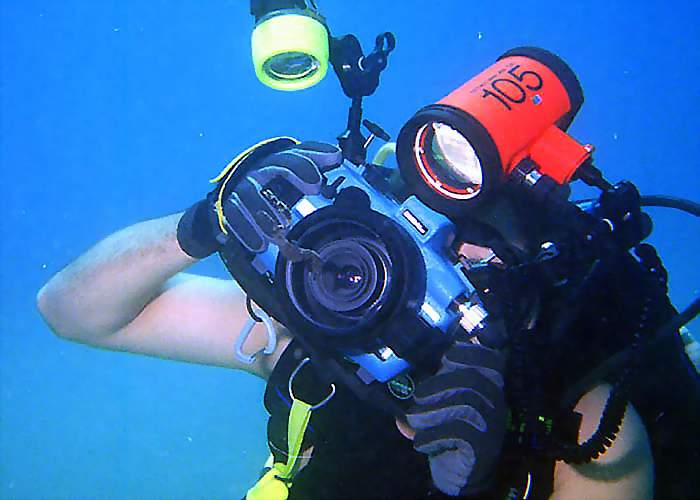
Photo: ozancokdeger.com
One other important difficulty in taking photographs underwater is that water is never gin clear, there are always myriads of minute animals and plants and other particles suspended in the water. The lack of clarity limits the distance we can see to about one hundred feet even in the clearest water. Since water is the major obstacle we try to reduce the amount of it between the camera lens and our subject by getting in close, certainly no more than one third of the distance we can see and usually much closer than this.
Since underwater photography is often performed while scuba diving, it is important that the diver-photographer be sufficiently skilled so that it remains a reasonably safe activity. Good scuba technique also has an impact on the quality of images, since marine life is less likely to be scared away by a calm diver, and the environment is less likely to be damaged or disturbed. There is the possibility of encountering poor conditions, such as heavy currents, tidal flow, or poor visibility. Generally, underwater photographers try to avoid these situations whenever possible.
So, to getting close to your subject, an invaluable technique for underwater photography using artificial light is to ensure that as little as possible of the light from the strobe is reflected back into the lens by particles in the water. This can be achieved by holding the strobe higher and to the left of your camera and aiming it at the subject so that only the water nearest the subject, and not the water nearest the lens, is illuminated. Since you need to get close, you should move slowly so as not to disturb your subject. Set up your camera and strobe ready for use before you make the approach, so that if you are using a manual system, you need only to make minor adjustments to the focus and aperture once in the desired position. Try to photograph your subject from an interesting angle, preferably framing it so that the background is not cluttered.
Labels: Underwater photography
Posted by ThanateTan at 6:58 AM 0 comments
Saturday, January 17, 2009
Visit Great Barrier Reef one time make your dream dive
The Great Barrier Reef of the east coast of Australia is one of the wonders of the natural world, it is the world's largest coral reef ecosystem. It was declared a World Heritage area in 1981 and added to the National Heritage List in 2007. It is a site of remarkable variety and beauty on the north-east coast of Australia. It contains the world’s largest collection of coral reefs, with 400 types of coral, 1,500 species of fish and 4,000 types of mollusc.
Photo: thelifeofdavid.com
The Great Barrier Reef can be seen from outer space and is the world's biggest single structure made by living organisms. This reef structure is composed of and built by billions of tiny organisms, known as coral polyps. The Great Barrier Reef supports a wide diversity of life, and was selected as a World Heritage Site in 1981. CNN has labelled it one of the 7 natural wonders of the world. The Queensland National Trust has named it a state icon of Queensland.
The Great Barrier Reef Visitors Bureau also has available a comprehensive selection of support information for the use of the intending traveller.
Photo: duatravel.com
The Great Barrier Reef has long been known to and utilised by the Aboriginal Australian and Torres Strait Islander peoples. Aboriginal Australians have been living in the area from at least 40,000 years ago and Torres Strait Islanders since about 10,000 years ago. For these 70 or so clan groups, the reef is also an important part of their culture and spirituality.
Find Cheap Hotels in Australia.
Labels: The Great Barrier Reef
Posted by ThanateTan at 7:49 AM 0 comments
Tuesday, January 13, 2009
Scuba Driving for Underwater
Scuba diving is swimming underwater, or taking part in another activity, while using a scuba set. By carrying a source of breathing gas, the scuba diver is able to stay underwater longer than with the simple breath-holding techniques used in snorkeling and free-diving, and is not hindered by air lines to a remote air source.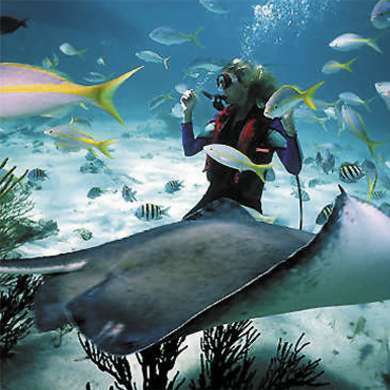
Photo: phuket-trips.com
The scuba diver typically swims underwater by using fins attached to the feet. However, some divers also move around with the assistance of a DPV, commonly called a "scooter", or by using surface-tethered devices called sleds pulled by a boat. Advances in underwater exploration began nearly three centuries ago using diving bells and large cumbersome sealed suits using pumped air from the surface. Only very recently advances in technology and mechanics have allowed people to visit this domain safely for exploration using comfortable, self-contained air delivery systems.
Water normally contains dissolved oxygen from which fish and other aquatic animals extract all their required oxygen as the water flows past their gills. Humans lack gills and do not otherwise have the capacity to breathe underwater unaided by external devices. Early diving experimenters quickly discovered it is not enough simply to supply air in order to breathe comfortably underwater.
Photo: atlastours.net
Today, scuba diving is accessible to almost anyone with only a modest investment in equipment. Anywhere you want to dive you can usually find a dive shop near-at-hand to rent tanks, go on a guided dive with a master diver, take a chartered boat or just strap on the tanks and swim out from the shore.
NAUI, the National Association of Underwater Instructors, was formed in 1960 to regulate and teach safe scuba diving to enthusiasts of this new sport. PADI, the Professional Association of Diving Instructors, was formed in 1967.
Labels: NAUI, PADI, Scuba Driving
Posted by ThanateTan at 9:27 AM 0 comments
Saturday, January 10, 2009
Deep sea vents
Te Deep sea vents are hydrothermal fissures which are present under the sea waters on ocean beds. Hydrothermal vents are locally very common because the earth is both geologically active and has large amounts of water on its surface and within its crust. Common land types include hot springs, fumaroles and geysers. The most famous hydrothermal vent system on land is probably within Yellowstone National Park in the United States. Under the sea, hydrothermal vents may form features called black smokers.
Photo: ocean-ridge.ldeo.columbia.edu
The most famous deep sea vents are probably the ones which are present in the Yellowstone National Park. These vents throw out superheated saline water which is not even suitable for any life forms. Also, these vents are located at depths where sunlight does not reach so the ecosystem that exists here is surviving completely without any sunlight. Bacteria are formed here which form the food of the slightly bigger organisms. Blind crabs and shrimps also exist at such levels.
Scientists first discovered undersea hot springs, known as hydrothermal vents, nearly 30 years ago. These vents, which are among the world's most extreme ecosystems, are found along the ocean ridge, 40,000 miles of underwater mountain range that zig-zags throughout the world's ocean basin. The vents spew super-hot, mineral-rich water that helps support exotic communities of animals and microbes. Issues surrounding research practices in vent areas have been sporadically discussed in the scientific literature since the late 1990s. Now, hydrothermal vents and the habitat they create are in the scientific, public, and political limelight as a result of improved technology that allows for greater studies of these remote areas.
The Mineral exploration companies, driven by the elevated price activity in the base metals sector during the mid 2000s, have turned their attention to extraction of mineral resources from hydrothermal fields on the seafloor. Significant cost reductions are, in theory, possible. Consider that in the case of the Mt Isa orebody, large amounts of capital are required to sink shafts and associated underground infrastructure, then laboriously drill and blast the ore, crush and process it, to win out the base metals, an activity which requires a large workforce.
Photo: science.psu.edu
A hydrothermal field, consisting of chimmneys and compacted chimmney remains, can be reached from the surface via a dynamically positioned ship, using conventional pipe, mined using modified soft rock mining technology, brought to the surface via the pipe, concentrated and dewatered then shipped directly to a smelter.
Deep sea vents are also known as deepwater seeps, deep-sea springs, and hydro-thermal vents. Found at the bottom of the ocean, they are created by volcanic and tectonic activity in areas where huge hostile plates are converging or spreading apart. Magma erupts along the margins of these plates, usually slowly, but sometimes with such ferocity that it creates instant lava lakes. The thick black smoke is actually a plume of metal-rich, superheated water billowing out of the silt- and sediment-covered, gray-and-black chimney-an underwater volcano.
Labels: Deep sea vents, Deep-sea springs, deepwater seeps, Hydro-thermal vents.
Posted by ThanateTan at 9:15 AM 0 comments
Wednesday, January 7, 2009
Snorkeling at the surface for beginer
Snorkeling is the practice of swimming with a diving mask. Before get down to underwater. Just learn to Snorkeling on the surface with diving mask and fins. It is a popular recreational activity, particularly at tropical resort destinations and at shallow scuba diving locations. Snorkeling is also employed by scuba divers when near the surface, and search and rescue teams may snorkel as part of a water-based search. The primary attraction of snorkeling is the opportunity to observe underwater life in a natural setting.
Photo: tahiti.pictures-pacific.com
You can snorkeling with no special training, only the ability to swim and to breathe through the snorkel. However, for safety reasons, instruction and orientation from a tour guide, dive shop, or equipment rental shop is recommended. Instruction generally covers equipment usage, basic safety, what to look for, and what to look out for, and conservation instructions. It is secured in place by two straps, one around the waist and another behind the user and between the legs.
The mask and snorkel are similar to those used in scuba diving, but since they are not subjected to the pressures of deep water, they can be more lightweight and comfortable. Swimfins used in snorkeling are usually longer than those used in diving. Most important for Snorkeling is swimmers snorkel, It is a tube about thirty centimeters long, usually J-shaped, fitted with a mouthpiece, and constructed of rubber or plastic. It is used for breathing air from above the water surface when the mouth and nose are submerged, either when snorkeling or during a surface swim before or after scuba diving.
The snorkel usually has a piece of rubber that attaches the snorkel to the outside of the strap of the diving mask, as sticking the snorkel in between the strap and the mask could cause the mask to leak, or risk losing the snorkel should the diver choose to switch to scuba. Snorkeler underwater, with snorkel's sump valve apparent in foreground.
The most common type of snorkel is a simple tube that is allowed to flood when underwater. The snorkeller expels water from the snorkel either with a sharp exhalation on return to the surface or by tilting the head backwards once the head is above water. Some modern snorkels have a sump in the mouthpiece to allow a small volume of water to remain in the snorkel without being inhaled when the snorkeler breathes. Some also have a one-way output valve in the sump, which automatically drains the sump as it fills with water. Some snorkels have float-operated valves attached to the surface end of the tube to keep water out when the snorkeller submerges. The more modern and quality snorkels have a one way valve on the top end that forces any water that splashes over the top to slide out of the sides, keeping the user's mouth free from water.
A longer tube would place the lungs in deeper water where the surrounding water pressure is higher and the lungs would be unable to inflate when the diver inhales, because the muscles that expand the lungs are not strong enough to operate against the higher pressure. Experienced snorkelers often start to investigate amateur free-diving, which should be preceded by at least some training from a dive instructor or experienced free-diver. By the way, if you like to explore deeper in underwater, you would be to scuba driving.
Labels: diving mask, Snorkeling, Snorkeling Set, swimfins
Posted by ThanateTan at 6:36 PM 0 comments
Sunday, January 4, 2009
Natural wonder at Galapagos Islands
The Galapagos Islands consists of 6 main islands 12 smaller islands and over 40 islets. The Galápagos are a ‘melting pot’ of marine species. Ongoing seismic and volcanic activity reflects the processes that formed the islands. These processes, together with the extreme isolation of the islands, led to the development of unusual animal life. Many people come from all over to see the turtles, whale sharks, hammerheads, colorful fish and other underwater marvels. Taking a land tour to see the islands themselves is a bonus that most divers enjoy as well.
Diving in the Galapagos Islands
By Enid Glasgow
The Galapagos Islands are known for many things. The same natural wonders that made the Galapagos such an interesting place to study by pioneers like Darwin have also made it an interesting place to vacation. Outdoor enthusiasts from all corners of the world who are traveling on a variety of different budgets make the trek to these islands every year. Whether they find interest in the unique bird populations on land or the one-of-a-kind underwater environment, these travelers share in common a true interest in adventure travel.
Photo: galapagosconnection.com
For underwater adventurists, the Galapagos Islands provide a unique experience. Thriving reefs, marine life and some of the best underwater visibility (often 100 feet or more) on the planet help to give the Galapagos Islands a reputation as one of the seven underwater wonders of the world. This is partially due to the fact that around 70,000 square kilometers of Galapagos marine areas are considered to be protected and the islands are far enough out of the way to make the destruction of this environment less likely.
What you can expect from a Galapagos diving Trip
To begin with, the Galapagos Islands offer something for divers of all skill levels. That being said, the water conditions of many dive areas are much more appropriate for intermediate and advanced divers. For any diver, the Galapagos is sure to deliver a life changing experience.
Photo: rphs.devisland.net
Currents - Due to strong currents, most dives done in the Galapagos are drift dives. Throughout different seasons, the Humboldt and Panama currents affect dive conditions. Divers not experienced in drift diving may want to steer clear of the dives offered in current-heavy areas.
Water Depth - While there are plenty of dives which take place shallower water, many of the most impressive dive experiences are to be had at deeper depths around 70-100 feet and beyond.
Temperature - Thermoclines play a big role in diving in the Galapagos. Surface temperatures reach between 18 and 30 degrees Celsius throughout the year. These temperatures can fluctuate as much as 5 degrees Celsius as you descend.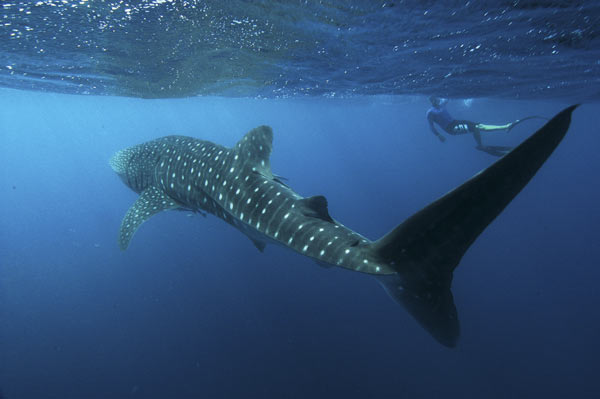
Photo: elasmodiver.com
Marine Life - Expect to see abundant marine life on any dive in Galapagos. As this area has been protected from hunting for quite some time, various marine specie populations have grown tremendously. Sharks, rays, sea lions, whales, reef fish and much more are not uncommon sites. In fact, rare whale sharks are seen fairly regularly in some dive zones.
Safety
Travelling with an experience dive company is important. It's also important to make your level of dive experience clear to your dive guides. Many dive charters do provide on-board safety equipment so you should ask about that as well. Lastly, since 2001, a hyperbaric chamber has been available in the Galapagos in case of emergencies.
Photo: galapagosyachts.com
Whether you trek to the Galapagos on a live aboard dive charter or enjoy a luxury cruise through the islands, take at least a couple days to explore everything the Galapagos have to offer, under the surface. A dive opportunity like you'll find in the Galapagos would be a shame to miss and an experience to remember.
Enid Glasgow is a travel writer who enjoys traveling to remote destinations. She enjoys traveling with Big Five Tours, providers of Galapagos cruises and luxury travel tours.
Galapagos Inn Hotel, Buzios
Photo: chimuadventures.com
To discover most of Buzios with ease, guests can use Galapagos Inn Hotel as their home base. Every room is equipped with the home comforts you would expect from a hotel of this class. The combination of Buzios's rich culture with modern conveniences and superb service makes this hotel stand out. For your reservation at the Galapagos Inn Hotel Buzios, simply select your dates and fill in our secure online booking form.
Labels: Galapagos Islands, Natural wonder, underwater environment
Posted by ThanateTan at 5:53 AM 0 comments
Thursday, January 1, 2009
Underwater photography
Most people who use to dive in underwater would like to take a photo about fishes or plants that at underwater sea. So, if you want to do. it would be use by Underwater camera for use under water as well. Therefore, you must know to take its by Underwater photography.
Photo: cameldive.com
Underwater photography is the process of taking photographs while under water. It is usually done while scuba diving, but can be done while snorkeling or swimming. Underwater imaging is considered an especially challenging area of photography, since it requires very specialized equipment and techniques to be successful.
Despite these challenges, it offers the possibility of many exciting and rare photographic opportunities. Animals such as fish and marine mammals are the most common subjects, but photographers also pursue shipwrecks, submerged cave systems, underwater "landscapes", and portraits of fellow divers.
The primary obstacle faced by underwater photographers is the extreme loss of color and contrast when submerged to any significant depth. The longer wavelengths of sunlight are absorbed quickly by the surrounding water, so even to the naked eye everything appears blue-green in color. The loss of color not only increases vertically through the water column, but also horizontally, so subjects further away from the camera will also appear colorless and indistinct. This effect is true even in apparently clear water, such as that found around tropical coral reefs.
Labels: Photographs under water, Underwater imaging, Underwater photography
Posted by ThanateTan at 11:34 PM 0 comments

